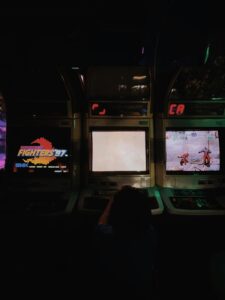In the vibrant arcade halls of Japan, amidst the cacophony of digital gunfire and the whir of prize machines, there exists a pulsating heartbeat that has, over the decades, echoed far beyond its origins. This heartbeat is the rhythm of Japan’s eclectic and mesmerizing rhythm games, or J-Rhythm games, which have carved a unique niche within the global gaming landscape. Beating to the Japanese rhythm involves more than just tapping and sliding on beat; it’s an immersive dive into a cultural phenomenon that blends music, gaming, and technology into one thrilling experience. From their origins in the 90s to their current state-of-the-art incarnations, J-Rhythm games offer a fascinating window into the evolution of digital entertainment and its cultural implications. This deep dive explores the history, evolution, and enduring appeal of J-Rhythm games, unveiling the magic behind the screens.
Exploring the Origins of J-Rhythm Games
The genesis of J-Rhythm games can be traced back to the early 90s when Japan’s arcade scene was at its zenith. It was here, among the myriad of gaming cabinets, that the first rhythm-based games began to appear, drawing inspiration from the country’s rich musical traditions. These early games, simplistic in design yet challenging in execution, laid the foundational mechanics of hitting notes to a beat that would define the genre. Notably, games like Dance Dance Revolution emerged, transforming arcades into vibrant dance floors and setting the stage for the genre’s explosive growth. The intertwining of gaming with popular J-Pop and traditional Japanese music created a unique cultural artifact that resonated with players on a profound level.
The Rise of J-Rhythm Games in the 90s
The 90s witnessed an unprecedented surge in the popularity of J-Rhythm games, fueled by advancements in technology and a burgeoning pop culture scene. Dance Dance Revolution (DDR) became a household name, not just in Japan but across the world, acting as a cultural ambassador of the J-Rhythm phenomenon. The success of DDR and its contemporaries spurred a wave of innovation within the genre, leading to the development of games that utilized a variety of interfaces, from dance mats to musical instruments. This era marked the golden age of J-Rhythm games, with arcades becoming sanctuaries for fans and enthusiasts who sought the thrill of perfecting their rhythmic timing to their favorite tunes.
Iconic J-Rhythm Games That Defined a Generation
Several J-Rhythm games have risen to iconic status, shaping the experiences of a generation and setting the benchmark for the genre. Dance Dance Revolution, with its energetic gameplay and diverse soundtrack, remains a quintessential example that brought rhythmic gaming to the mainstream. Following closely, Taiko no Tatsujin, with its engaging drumming mechanic, captured the hearts of players by incorporating traditional Japanese drumming into a colorful and competitive format. Another seminal title, Beatmania, introduced gamers to a DJ-like experience, mixing tracks and hitting notes in a simulation of turntablism. These games not only defined a generation but also paved the way for future innovations in the genre.
How J-Rhythm Games Are Evolving with Technology
The evolution of J-Rhythm games is intrinsically linked to advancements in technology, from the simple button presses of the early days to the immersive virtual reality experiences of the present. Modern J-Rhythm games leverage cutting-edge technology to offer more nuanced and engaging experiences. Augmented reality (AR) and virtual reality (VR) have introduced players to a new dimension of gameplay, where physical movement and virtual environments blend seamlessly. Cloud gaming and mobile platforms have also expanded the accessibility of J-Rhythm games, allowing players to enjoy high-quality rhythm gaming experiences on the go. These technological advancements have not only expanded the gameplay mechanics but have also enriched the visual and auditory experience, making each session more immersive.
The Cultural Impact of J-Rhythm Games in Japan
In Japan, J-Rhythm games are more than just a form of entertainment; they are a vibrant part of youth culture and social interaction. Arcades, once the heart of the J-Rhythm scene, have evolved into communal spaces where fans gather to share their passion, compete, and socialize. The genre’s influence extends beyond gaming, affecting fashion, music, and dance. J-Rhythm games have become a platform for J-Pop artists to debut new singles and for traditional musicians to reach younger audiences. The games also foster a sense of community and shared identity among players, who often form tight-knit groups united by their love for rhythm gaming.
J-Rhythm Games’ Expansion into Global Markets
The allure of J-Rhythm games has not been confined to Japan. Over the years, the genre has found a passionate following across the globe, facilitated by the internet and the rise of esports. International tournaments and conventions often feature J-Rhythm games as a highlight, drawing competitors and fans from all corners of the world. The globalization of J-Pop and interest in Japanese culture have further fueled the genre’s international appeal. Developers have responded by localizing games for various markets and incorporating a wider range of music genres to cater to global tastes. This global expansion has not only diversified the player base but has also introduced new influences into the genre, creating a dynamic cross-cultural exchange.
The world of J-Rhythm games is a testament to the enduring power of music and rhythm as universal languages of expression and enjoyment. From their origins in the bustling arcades of Japan to their presence on the global stage, these games have evolved into a rich cultural phenomenon that transcends borders and languages. The journey of J-Rhythm games is one of innovation, community, and cultural exchange, offering a unique blend of entertainment that continues to captivate hearts and minds around the world. As technology advances and the global community grows closer, the beat of J-Rhythm games promises to keep pulsing, inviting players old and new to join in the rhythm and share in the joy of music and gaming.








